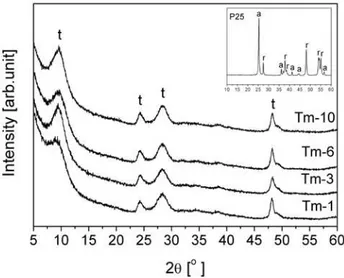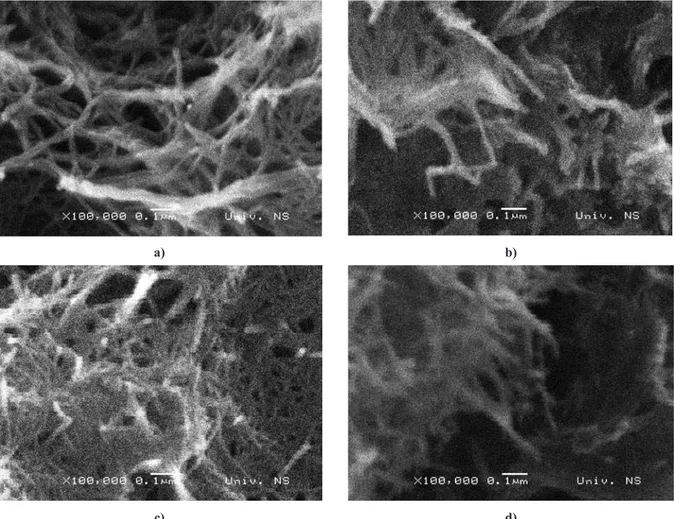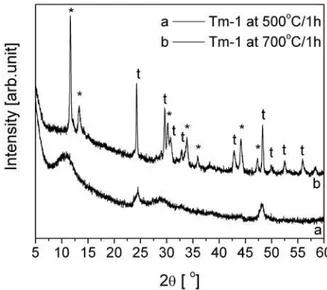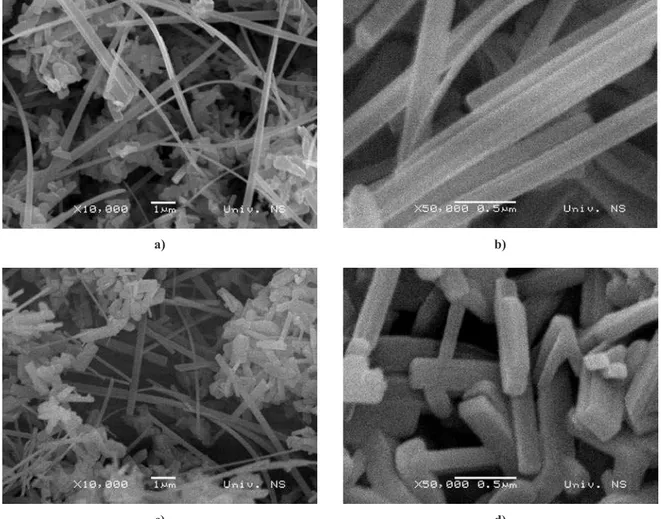* Corresponding author: tel: +381 21 485 3758 fax: +381 21 450 413, e-mail: ljunik@uns.ns.ac.yu
Synthesis and characterization of one-dimensional titanate structure
Ljubica M. Nikolić
1*, Marija Maletin
1, Paula Ferreira
2, Paula M. Vilarinho
21Department of Materials Engineering, Faculty of Technology, University of Novi Sad,
Bul. Cara Lazara 1, 21000 Novi Sad, Serbia
2Department of Ceramics and Glass Engineering, CICECO, University of Aveiro, 3810-193 Aveiro, Portugal
Received 30 September 2008; received in revised form 21 November 2008; accepted 20 December 2008
Abstract
One-dimensional titania structures were synthesized trough a simple hydrothermal process in a highly alkaline conditions. The aim of this work was to elucidate the effect of time on the formation of 1D titanates as well on its structural characteristics (morphology, phase composition, surface area). Apart from that, the effect of heat treatment conditions on the stability of titanate based 1D samples has been investigated. The results have revealed that it is possible to form one-dimensional titanates already after 1 hour of hydrothermal synthesis. Although the composition of titanates is still under debate, the results probably correspond to the layered so-dium titanates. The 1D prepared structures show a remarkable stability during heating, remaining the basic morphology and composition even up to 700°C.
Keywords: one-dimensional titanates, hydrothermal synthesis, thermal stability
I. Introduction
In the past decades, titania as semiconducting
ma-terial has attracted a great scientiic interest due to its wide range of applications in many ields such
as catalysis and electronics, namely in manufactur-ing different sensor and optical devices [1,2]. Proper-ties and applications of titania depend on its type of crystalline phase, dimension of structure units, mor-phology, composition, etc. [3,4]. Discovery of carbon nanotubes and their exceptional properties related to the one dimensional structure (1D) has introduced a new challenge in research and tailoring one-dimen-sional structure of titania. One-dimenone-dimen-sional nano-structured materials (nanotubes, nanorods,
nanow-ires, nanobelts) considering their speciic structural
characteristics, primarily their high aspect ratio and
large speciic surface area, show fascinating proper -ties compared to the bulk counterparts [5]. Among these materials, 1D titanate (titania) nanomaterials have received a great deal of attention because of their technological importance in solar cells, photo-electrochemical conversion, as photocatalysts in the degradation of polutant in enviromental protection,
as absorbents, catalytic support, gas sensors [6–8]. Type and structural characteristics of 1D materials, as well as their properties are strongly determined on the processing method and conditions of preparation. In general, there are three main approaches for the preparation of these materials: template methods [9], anodic oxidation [10,11], and wet chemical methods [12–14]. Recently, the synthesis of titania 1D struc-tures fabricated by a hydrothermal method proposed by Kasuga et al has received considerable attention because of its low cost and simplicity.
Besides the growing interest in obtaining 1D tita-nates, the formation mechanism and phase of these materials are still subjects of debate [15]. Accord-ing to the literature, different crystal structures and compositions have been suggested, such as trititanate (H2Ti3O7), tetratitanate H2Ti4O9⋅H2O, lepidocronite ti-tanates HxTi2-x/4□x/4O4, H2Ti3O7⋅xH2O, NaxH2-xTi3O7 and TiO2 anatase [13–16]. In addition, some authors have concluded that 1D structures were formed by rolling of single layers peeled from crystal plates possibly due
to hydrogen deiciency in surface [13]. On the other
Au-L.M. Nikolic et al. / Processing and Application of Ceramics 2 [2](2008) 109-114
thors have suggested that the rollup theory is only
val-id when local concentration luctuations generate ex -treme conditions (temperature, pH and reaction time) at the surface of nanoparticles. It was claimed that
lo-cal concentration luctuations wich have appeared on
the crystallite of starting material under hydrothermal conditions, initiate the formation of nanoloops from the starting material, which then become seeds for an oriented crystal growth process leading to titanate nanotubes. The shape of the cross-section is deter-mined by the curvature of the seeding nanoloop. Since
these are lexible ensembles only a few nanometers in
length and diameter, they can give rise to spiral, on-ion, or even multiple-spiral nanotube cross-sections. The thermal stability of 1D nanostructure is of crit-ical importance for their implementation as building blocks in nanoscale electronic and photonic devices, but there are limited studies considering this subject [19]. It is important to note that the products obtained after thermal decomposition of the 1D titanate can provide some crucial evidence necessary to elucidate their original crystal structure.
The main subject of this work is to investigate the early stage of titanate formation, but also the effect of heat treatment conditions on their stability is discussed.
II. Experimental
One dimensional nanostructured titania based ma-terials were synthesized by hydrothermal process-ing in highly alkaline conditions. Commercial titania powder (Degussa P-25) was used as a starting materi-al. Following the hydrothermal procedure, TiO2 powder was dispersed in an aqueous solution of 10 M NaOH, and ultrasonically treated for an hour. After the treat-ment in ultrasonic bath the specimen was transferred into a sealed vessel (volume 100 ml) with 84%
au-toclave illing fraction [20]. The hydrothermal reac -tion was carried out in an oil bath at 150°C for
dif-ferent periods of time up to 10 hours. As-synthesized powders were separated from the slurry and washed a number of times with distilled water and ethanol until neutral pH was reached. Finally, formed tita-nia based structures were dried at 120°C for one day. In order to investigate the thermal stability, obtained titanates were heated at different temperatures up to 900°C. The samples were noted as Tm-x, were x stands for the time of hydrothermal reaction (1, 3, 6 and 10 hours).
As-synthesized powders were characterized by X-ray diffraction, XRD (Siemens D500 instrument
us-ing Ni-iltered Cu-Kα radiation of wavelength 1.5418
Å), Fourier-transform infrared spectroscopy, FT-IR (Nicolet-Nexsus 670 FT-IR), low temperature nitro-gen adsorption, BET (Quantachrom Autosorb-3B in-strument), scanning electron microscopy, SEM (JEOL JSM 6460LV) with energy-dispersive X-ray spectros-copy, EDS (Oxford INCA EDS system) and transmis-sion electron microscopy, TEM (Hitachi H9000-NA).
III. Results and Discussion
The typical FT-IR spectrum for commercial powder P25 (mixture of anatase and rutile) is given in the left upper corner of the Fig.1, and shows the characteristic bands in the range 450–700 cm-1 related to the different
types of Ti-O-Ti vibrations. However, according to the spectra of the as-prepared titanates (Fig. 1), the shape of
these bands was changed, implying the structure modii -cation and formation of one-dimensional titanate struc-ture. In addition, new band appeared at around 900 cm-1
which corresponds to the vibration of Ti-O nonbridging oxygen bonds, and probably the formation of Ti-O-Na bonds. This band is typical for one-dimensional struc-tures [4], but the small intensity could be explained by the very low concentrations of Na ions (due to exten-sive ion exchange with H+ during washing). The shape
and intensity of the observed bands are changing with
Figure 1. FT-IR spectra of as-prepared 1D titanates and starting powder P25 (in the left upper corner)
Figure 3. SEM images of as-prepared 1D titanates: a) Tm-1, b)Tm-3, c) Tm-6 and d) Tm-10
a) b)
c) d)
the time of hydrothermal reaction. A broad and intense band located around 3400 cm-1 can be ascribed to
OH-stretching vibrations. The presence of this peak implies the existence of hydroxyl groups and large amount of water molecules in the surface and interlayer space. Vi-bration around 1650 cm-1 also conirmed the presence
of water and can be assigned to H-O-H bending vibra-tions of water.
Obtained XRD results confirmed the FT-IR find-ings as can be observed according to patterns pre-sented in Fig. 2. In order to follow the structure changes in the powder after hydrothermal reaction, the XRD pattern of the starting material is given in the corner. It is important to mention that 1D tita-nate structures are present already after one hour of hydrothermal synthesis, which is an unusually short time, never documented in the literature according to our knowledge. The XRD patterns showed main-ly four diffraction peaks at 2θ ~ 9.5, 24, 28 and 48° characteristic for Na2Ti3O7 type of titanates (JCP-DS 31-1329), in accordance with the literature [2,16,21]. These peaks could be ascribed to the in-terlayer spacing typical for one-dimensional tita-nate structure [2,4,13–16]. The intensity of the peak around 9.5° is increasing with the reaction time, in-dicating the rise in crystallinity.
SEM analysis of as-prepared powders conirmed
that one dimensional titanate structure is obtained al-ready after one hour of hydrothermal reaction, Fig. 3. Morphology of these forms depends on reaction time and in order to investigate it more precisely and try to obtain information on the formation mechanism, TEM analyses were conducted and the results depicted in Fig. 4. According to TEM images, nanosheets and also nano-tubes are observed. Some of these nanonano-tubes are only partially scrolled, so it could be assumed that 1D struc-tures are most probably formed by delamination and rolling-up of precursor nanosheets into scrolled nano-tubes. Of course, to state this possible way of forma-tion, further investigations are necessary. It is important to notice that particle-like morphology of the precur-sor, does not exist any more, implying that the rate of hydrothermal reaction is very high in the early stage of one-dimensional structure formation. In addition, the
speciic surface area of these structures is remarkably
increased (even up to 450 m2/g) in respect to the
start-ing powder, P25 (about 80 m2/g).
Composition of obtained 1D titanates, suggested
considering the XRD results, is conirmed by EDS anal -yses, Fig. 5. There is a visible peak of sodium ion, which shows that the formed titanates contain Na+, probably
L.M. Nikolic et al. / Processing and Application of Ceramics 2 [2](2008) 109-114
Fig. 6 shows the XRD patterns of Tm-1 sample cal-cined at different temperatures for one hour. The pattern of the samples heat treated at 500°C is very similar to the as-prepared 1D titanates, except that the intensity of diffraction peak near 2θ ~ 10° was shifted towards high-er angle value indicating a decrease in the inthigh-erlayhigh-er distance for this plane. This contraction of layers may be due to the release of water molecules adsorbed and present in interlayer spacing. The remaining diffraction
peaks are only slightly modiied suggesting the mainte -nance of the crystallographic and morphological struc-ture up to 500°C. The observed phase is stable even
af-ter calcination at 700°C, although other titanate phases are starting to appear and all can be ascribed to sodium titanates (Na2Ti3O7 - JCPDS 31-1329; Na2Ti6O13 - JCP-DS 37-0951). As expected the calcined forms show bet-ter crystallinity in respect to as-prepared titanates. Sim-ilar results were obtained for the other samples.
The change in shape and morphology of obtained titanates in relation to the calcination temperature was followed by SEM. Fig. 7 shows the SEM micrographs of titanates heated at 900°C. It can be noticed that dur-ing heat treatment the one-dimensional morphology remained, but with different aspect ratios in
compari-Figure 6. XRD patterns of Tm-1 sample after calcination at 500°C/1h and 700°C/1h (t - Na2Ti3O7, * - Na2Ti6O13) Figure 5. EDS spectrum of as-prepared Tm-10 sample
a) b)
son to as-prepared samples. This processinduces a
va-riety of 1D structures like whiskers, belts, rods, ibers etc. Temperature affected the process of densiication
and crystal growth, which resulted in coarsening of 1D structures.
VI. Conclusions
One-dimensional titanate structures were success-fully obtained directly from a highly alkaline solution of titania powder following a hydrothermal process al-ready after one hour of synthesis. We have shown that as-prepared titanates contain sodium with a composi-tion probably based on sodium trititanates. The study of thermal effect has shown that obtained one-dimension-al titanates maintain the same composition under heat-ing up to 500°C. Heat treatment at higher temperatures induces the appearance of the other titanate phases, but they preserve the morphology, which is typical for one-dimensional structures.
Acknowledgements: This work was supported by
the Serbian Ministry of Science, Project “Synthesis of nanopowders and processing of ceramics and nano-composites for application in novel technologies”, No. 142059 and COST 539 Project.
References
1. E.I. Kapinus, T.A. Khalyavka, V.V. Shimanovskaya, T.I. Viktorova, V.V. Strelko, “Photocatalytic activity of spec-tro-pure titanium dioxide: Effects of crystalline structure,
speciic surface area and sorption properties”, Inter. J. Photoen., 05 (2003) 159.
2. J. Yu, M. Zhou, “Effects of calcinations temperature on microstructures and photocatalytic activity of titanate
nanotube ilms prepared by an EPD method”, Nano-technol., 19 (2008) 045606 (6pp).
3. H. Liu, L. Gao, “Preparation and properties of
nanoctystal-line α-Fe2O3-sensitized TiO2 nanosheets as a visible light
photocatalyst”, J. Am. Ceram. Soc., 89 [1] (2006) 370–373 4. J.A. Toledo-Antonio, S. Capula, M.A. Cortes-Jacome, C.
Angeles-Chavez, E. Lopez-Salinas, G. Ferrat, J. Navarre-te, J. Escobar, “Low-tempareature FTIR study of CO ad-sorption on titania nanotubes”, J. Phys. Chem. C, 111
(2007) 10799–10805.
5. W. Wang, H. Lin, J. Li, N. Wang, “Formation of titania nano-arrays by hydrothermal reaction and their application in pho-tovoltaic cells”, J. Am. Ceram. Soc., 91 [2] (2008) 628–631. 6. F. Dong, W. Zhao, Z. Wu, “Characterization and pho-tocatalytic activities of C, N and S co-doped TiO2 with
1D nanostructure prepared by the nano-coninement
effect”, Nanotechnol., 19 (2008) 365607 (10pp).
Figure 7. SEM images of titanate samples heated at 900oC: a) Tm-1, b) Tm-3, c) Tm-6 and d) Tm-10
a) b)
L.M. Nikolic et al. / Processing and Application of Ceramics 2 [2](2008) 109-114
7. S. Yuan, Q. Sheng, J. Zhang, F. Chen, M. Anpo, Q. Zhang, “Synthesis of La3+ doped mesoporous titania
with highly crystallized walls”, Micropor. Mesopor. Mater., 79 (2005) 93–99.
8. M. Sacerdoti, M.C. Dalconi, M.C. Carotta, B. Cavicchi, M. Ferroni, S. Colonna, M.L. Di Vonad, “XAS investi-gation of tantalum and niobium in nanostructured TiO2 anatase”, J. Solid State Chem., 177 (2004) 1781–1788. 9. S. Zhang. C. Liu, Y. Liu, Z. Zhang, G. Li, “Fabrication
of micrometer-scale anatase-phase TiO2 congeries as-sembled with hollow spheres”, J. Am. Ceram. Soc., 91
[6] (2008) 2067–2070.
10. M. ’Ou Li, X. Xiao, R. Liu, “Synthesis and bioactivi-ty of highly ordered TiO2 nanotube arrays”, Appl. Surf. Sci., 255 [2] (2008) 365–367.
11. Y. Yin, Z. Jin, F. Hou, X. Wang, “Synthesis and mor-phology of TiO2 nanotube arrays by anodic oxidation
using modiied glucerol-based electrolytes”, J. Am. Ce-ram. Soc., 90 [8] (2007) 2384–2389.
12. T. Kasuga, M. Hiramatsu, A. Hoson, T. Sekino, K. Ni-ihara, “Titania nanotubes prepared by chemical pro-cessing”, Adv. Mater., 11 [15] (1999) 1307–1311. 13. C.-C. Tsai, H. Teng, “Structural features of nanotubes
synthesized from NaOH treatment on TiO2 with different post-treatments”, Chem. Mater., 18 (2006) 367–373. 14. H.-H. Ou, S.-L. Lo, “Review of titania nanotubes
syn-thesized via the hydrothermal treatment: Fabrication,
modiication and application”, Sep. Purif. Technol., 58
(2007) 179–191.
15. S. Xu Chun, E. Yang, Z. Yi Fan, “Synthesis of MxH y-Ti3O7 nanotubes by simple ion-exchanged process and their adsorption property”, Chin. Sci. Bull., 52 [18] (2007) 2491–2495.
16. M. Qamar, C.R. Yoon, H.J. Oh, N.H. Lee, K. Park, D.H. Kim, K.S. Lee, W.J. Lee, S.J. Kim, “Prepa-ration and photocatalytic activity of nanotubes ob-tained from titanium dioxide”, Catalysis Today, 131
(2008) 3–14.
17. A. Kukovecz, M. Hodos, E. Horvth, G. Radnczi, Z. Konya, I. Kiricsi, “Oriented crystal growth model ex-plains the formation of titania nanotubes”, J. Phys. Chem. B, 109 [38] (2005) 17781–17783.
18. E. Horvth, A. Kukovecz, Y. Konya, I. Kiricsi, “Hydro-thermal conversion of self-assembled titanate nano-tubes into nanowires in a revolving autoclave”, Chem. Mater., 19 [4] (2007) 927–931.
19. Y. Yang, X. Wang, L. Li, “Crystallization and phase transition of titanium oxide nanotube arrays”, J. Am. Ceram. Soc., 91 [2] (2008) 632–635.
20. B. Poudel, W.Z. Wang, C. Dames, J.Y. Huang, S. Kun-war, D.Z. Wang, D. Banerjee, G. Chen, Z.F. Ren, “For-mation of crystallized titania nanotubes and their trans-formation into nanowires”, Nanotechnol., 16 (2005) 1935.



